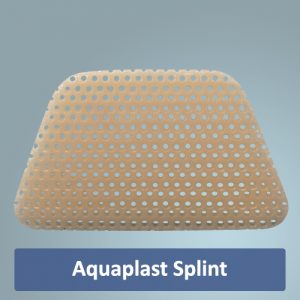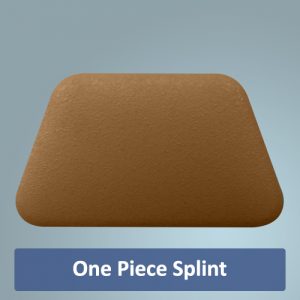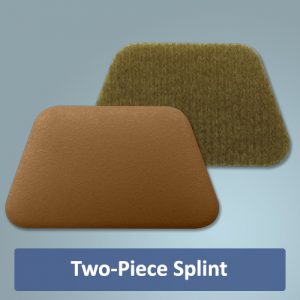Denver Splint for Nasal Surgery
Moldable aluminum splint with multiple layers provides cushioned pressure on subcutaneous tissue.
SurgiPlast Splint for Nasal Surgery
Thermoplastic splint that molds to the patient's nose, stabilizing the dorsum and minimizing edema. The primary advantage is the ability to trim the splint to fit the patient!
Simple, Effective Nasal Splints
Splint Features
- 7-10 day wear
- Adhesive
- Easily moldable
- Quick application
- Inconspicuous
- Water-resistant
Kits Include
- Instruction sheet
- One alcohol wipe
- One skin prep
- One dorsal pad
- Pre-cut Protector Strips
- One Denver or SurgiPlast Nasal Splint
Nasal Splint Products
-
Aquaplast Splint
Login to see Prices Add to Cart This product has multiple variants. The options may be chosen on the product page -
Denver Splint 3000 Series
Login to see Prices Add to Cart This product has multiple variants. The options may be chosen on the product page -
Denver Splint 2000 Series
Login to see Prices Add to Cart This product has multiple variants. The options may be chosen on the product page -
Two Piece Denver Splint 1500 Series
Login to see Prices Add to Cart This product has multiple variants. The options may be chosen on the product page
Types of Nasal Splints
Nasal splints are devices used to support and protect the nose. There are a variety of different types of nasal splints, but all serve the same purpose: to keep the nose stable and protected after surgery or an injury. Nasal splints are typically made from either plastic or metal, and are designed to be as comfortable as possible for the patient.
External Nose Splints vs Internal Nose Splints
External nose splints are the most common type of nasal splint. They are usually made from moldable aluminum or thermoplastic and can be trimmed to fit the patient's nose. External splints are typically worn for 7-10 days after nasal surgery or an injury.
Internal splints are usually used after a septoplasty or correction of a deviated septum. They’re made up of two pieces of plastic or other firm but flexible material inserted inside the nose to support the bridge between the nostrils, or septum.
Denver Nasal Splints vs SurgiPlast Nasal Splints
Denver Splints and SurgiPlast Splints are two common types of external splints. Denver Splints are made from moldable aluminum, and SurgiPlast Splints are made from thermoplastic. Both types of splints are designed to be as comfortable as possible for the patient and can be trimmed to fit the patient's nose.
The Denver Splint for Nasal Surgery is a moldable aluminum splint that provides cushioned pressure on subcutaneous tissue. This type of splint is often used to stabilize the dorsum and minimize edema after nasal surgery.
The SurgiPlast Splint for Nasal Surgery is a thermoplastic splint that molds to the patient's Nose, stabilizing the dorsum and minimizing edema. The primary advantage of this type of splint is the ability to trim the splint to fit the patient!
Types of Nose Surgeries
Nose surgeries are commonly performed procedures that can correct a variety of nasal issues. There are many different types of nose surgeries, each with their own benefits and risks. This surgery is often a last resort for people who have been struggling with chronic sinus infections, difficulty breathing, or other issues.
There are two main categories of nasal surgery: internal and external.
Internal Nose Surgery vs External Nose Surgery
Internal surgery is performed through incisions made inside the nostrils, while external nose surgery is performed through an incision made across the columella, the strip of tissue that separates the nostrils.
The type of nasal surgery that is right for you will depend on your individual situation and goals. Your surgeon will be able to discuss all of your options with you and help.
Things to consider when choosing the right nose implant
When considering nose surgery or a nose job, one of the most important decisions is choosing the right implant. There are many different types of nose implants available, so it's important to do your research and choose the one that's right for you. Here are a few things to keep in mind when selecting a nose implant:
1. The type of implant:
There are many different types of nose implants available, so it's important to do your research and choose the one that's right for you. Here are a few things to keep in mind when selecting a nose implant:
- The size and shape of the implant should be compatible with your natural facial proportions.
- The implant should be made from a material that is safe and compatible with your body.
- The implant should be easy to insert and remove and have a low risk of rejection by your body.
2. The surgeon's experience:
When choosing a nose surgeon, it's important to choose someone who is experienced in performing this type of surgery and know how to work with internal nose splints and external nose splints.
Make sure to ask about the surgeon's experience with the type of nose splint you are considering, the training they have had, and the success rate with this type of nasal surgery procedure.
3. The cost:
Nose surgery can be expensive, so it's important to compare prices before you choose a surgeon and nose splint. Be sure to get quotes from several surgeons before making your decision.



